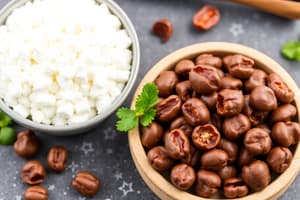Podcast
Questions and Answers
What is the term for the bond formed between two amino acids?
What is the term for the bond formed between two amino acids?
- Covalent bond
- Ionic bond
- Peptide bond (correct)
- Hydrogen bond
Which of the following best describes a tripeptide?
Which of the following best describes a tripeptide?
- A chain of three amino acids (correct)
- A chain of two amino acids
- A chain of five amino acids
- Any combination of amino acids
What distinguishes complete proteins from incomplete proteins?
What distinguishes complete proteins from incomplete proteins?
- Incomplete proteins are only plant-based
- Incomplete proteins are more digestible
- Complete proteins provide all essential amino acids (correct)
- Complete proteins contain fewer amino acids
What is the primary role of amino acids in the body?
What is the primary role of amino acids in the body?
Which group is not typically considered an essential amino acid for adults?
Which group is not typically considered an essential amino acid for adults?
Which statement accurately describes amino acid complementarity?
Which statement accurately describes amino acid complementarity?
Which of the following is a dietary source of complete protein?
Which of the following is a dietary source of complete protein?
What does the 'R' in the amino acid structure represent?
What does the 'R' in the amino acid structure represent?
What happens when the amino group of one amino acid reacts with the carboxyl group of another?
What happens when the amino group of one amino acid reacts with the carboxyl group of another?
What is the function of the carboxyl group in an amino acid?
What is the function of the carboxyl group in an amino acid?
What is generally considered a protein?
What is generally considered a protein?
Which type of bond is essential for linking amino acids together?
Which type of bond is essential for linking amino acids together?
What proportion of the human body's dry matter is composed of protein?
What proportion of the human body's dry matter is composed of protein?
Which of the following correctly describes the average length of a protein?
Which of the following correctly describes the average length of a protein?
What additional types of chemical bonds can link polypeptide chains?
What additional types of chemical bonds can link polypeptide chains?
The unique biological function of a protein is primarily determined by its:
The unique biological function of a protein is primarily determined by its:
Which statement is true regarding insulin?
Which statement is true regarding insulin?
Which of the following contributes the least to the dry matter of the human body?
Which of the following contributes the least to the dry matter of the human body?
How do amino acids relate to the formation of proteins?
How do amino acids relate to the formation of proteins?
What is the primary composition of the human body by percentage of dry matter?
What is the primary composition of the human body by percentage of dry matter?
What is true about the average composition of the human body's dry matter?
What is true about the average composition of the human body's dry matter?
How does the length of proteins compare to typical words?
How does the length of proteins compare to typical words?
What is a correct statement regarding insulin's classification in relation to proteins?
What is a correct statement regarding insulin's classification in relation to proteins?
Which statement about the formation of proteins is accurate?
Which statement about the formation of proteins is accurate?
What types of structures can result from the linking of polypeptide chains?
What types of structures can result from the linking of polypeptide chains?
What proportion of the human body’s dry matter consists of carbohydrates?
What proportion of the human body’s dry matter consists of carbohydrates?
Which option accurately describes the role of amino acids in relation to proteins?
Which option accurately describes the role of amino acids in relation to proteins?
What percentage of a non-obese man's body is typically composed of water?
What percentage of a non-obese man's body is typically composed of water?
What is the primary structure that forms when two amino acids are linked together?
What is the primary structure that forms when two amino acids are linked together?
Which of the following describes a characteristic of complete proteins?
Which of the following describes a characteristic of complete proteins?
What is true about the concept of amino acid complementarity?
What is true about the concept of amino acid complementarity?
Identify the incorrect statement about amino acids.
Identify the incorrect statement about amino acids.
When discussing protein structure, what sequence correctly represents the complexity of protein formation?
When discussing protein structure, what sequence correctly represents the complexity of protein formation?
Which amino acid structure part is involved in forming peptide bonds?
Which amino acid structure part is involved in forming peptide bonds?
Which of the following represents the main function of protein in the human body?
Which of the following represents the main function of protein in the human body?
How many amino acids must be combined to form a tripeptide?
How many amino acids must be combined to form a tripeptide?
What percentage of the human body's dry matter is made up of protein?
What percentage of the human body's dry matter is made up of protein?
Insulin is classified as a polypeptide because it consists of 51 amino acids.
Insulin is classified as a polypeptide because it consists of 51 amino acids.
What type of bond is formed between amino acids during protein synthesis?
What type of bond is formed between amino acids during protein synthesis?
The average length of a protein is approximately _____ amino acids.
The average length of a protein is approximately _____ amino acids.
Which of the following structures can proteins form due to chemical linkages?
Which of the following structures can proteins form due to chemical linkages?
Match the following protein components with their respective percentage in the dry matter of a non-obese man:
Match the following protein components with their respective percentage in the dry matter of a non-obese man:
What gives a protein its unique biological function?
What gives a protein its unique biological function?
Hydrogen bonds are a type of chemical bond that can link polypeptide chains.
Hydrogen bonds are a type of chemical bond that can link polypeptide chains.
Which of the following amino acids are essential for adults?
Which of the following amino acids are essential for adults?
All proteins are considered complete proteins.
All proteins are considered complete proteins.
What do you call the chain formed by the linkage of amino acids?
What do you call the chain formed by the linkage of amino acids?
A chain of two amino acids is known as a ______.
A chain of two amino acids is known as a ______.
Match the following terms related to proteins with their definitions:
Match the following terms related to proteins with their definitions:
Which of the following is a primary function of proteins?
Which of the following is a primary function of proteins?
Amino acid complementarity refers to the ability of different proteins to interact with each other.
Amino acid complementarity refers to the ability of different proteins to interact with each other.
Name one dietary source of protein.
Name one dietary source of protein.
Flashcards are hidden until you start studying
Study Notes
Protein Basics
- Proteins are composed of amino acids, which are the fundamental building blocks of proteins. These organic compounds play a central role in biological systems and are crucial for a myriad of bodily functions.
- Each amino acid consists of three main components: an amino group (-NH2), a carboxyl group (-COOH), and a variable side chain, known as the R group, which determines the unique characteristics of each amino acid. This structural diversity allows for a variety of functions throughout the body.
- Amino acids link together through peptide bonds, a type of covalent bond that forms when the carboxyl group of one amino acid reacts with the amino group of another, releasing a molecule of water in the process. This reaction results in the formation of chains called polypeptides, which can vary in length and sequence, ultimately determining the nature and function of the resulting protein.
Peptide Formation
- Two amino acids combine to form a dipeptide, while three amino acids create a tripeptide. When peptide chains exceed 50 amino acids, they are considered proteins. The sequence and arrangement of these amino acids dictate the protein’s structure and function.
- Insulin is an essential hormone and an example of a small protein, consisting of 51 amino acids arranged in a specific sequence. Its primary role is to regulate blood glucose levels, highlighting the significance of protein structure in biological regulation.
- Chemical bonds such as hydrogen and sulfur connect polypeptide chains to create complex structures, including coils (alpha helices), sheets (beta sheets), and globules. These intricate formations enable proteins to perform their various functions, as the three-dimensional shape is crucial for biological activity.
Body Composition
- The human body is composed of approximately 60% water, a vital component necessary for numerous physiological processes, including temperature regulation, nutrient transport through bodily fluids, and waste removal through urination. Water also acts as a lubricant for joints and carries nutrients to cells, emphasizing its importance for overall health and homeostasis.
- The remaining 40% of body composition is classified as dry matter, which is critical for the structural framework and functional processes of the body. Within this category, protein constitutes about 40%, serving as a vital building block for tissues, hormones, enzymes, and components of the immune system. Fats also make up roughly 40%; they play crucial roles in energy storage, insulation against environmental variations, and protection of vital organs from physical damage. Additionally, minerals account for about 15%, playing essential roles in bone health, nerve transmission, and maintenance of fluid balance. Carbohydrates comprise less than 5% of body composition, but they serve as an immediate source of energy for metabolic activities.
- Due to their significant contribution to the body’s dry matter, proteins and fats are recognized as primary constituents, underscoring their roles in promoting overall health, wellness, and metabolic efficiency. This balance between these macronutrients supports everyday physiological functions and endurance.
Functions of Protein
- Proteins perform a plethora of key roles in biological processes; they are involved in enzyme activity, serving as catalysts for biochemical reactions, and providing structural support by forming cellular frameworks in tissues such as muscles and cartilage. Moreover, proteins have hormonal functions, regulating various processes within the body and maintaining homeostasis.
- The unique three-dimensional shapes of proteins are critical as they determine the specific interactions and biological functions of each protein. These shapes arise from the precise folding patterns dictated by the amino acid sequence, as well as the presence of chemical interactions within the protein itself, such as ionic bonds, hydrogen bonds, and disulfide linkages, all contributing to the protein's stability and functionality.
Essential Amino Acids
- Essential amino acids for adults must be obtained through dietary sources, as the human body lacks the ability to synthesize them internally. This necessitates the inclusion of protein-rich foods in the diet to ensure adequate intake.
- Examples of essential amino acids include leucine (important for protein synthesis and muscle repair), isoleucine (involved in energy production and immune function), and valine (supports muscle metabolism and energy
Studying That Suits You
Use AI to generate personalized quizzes and flashcards to suit your learning preferences.




